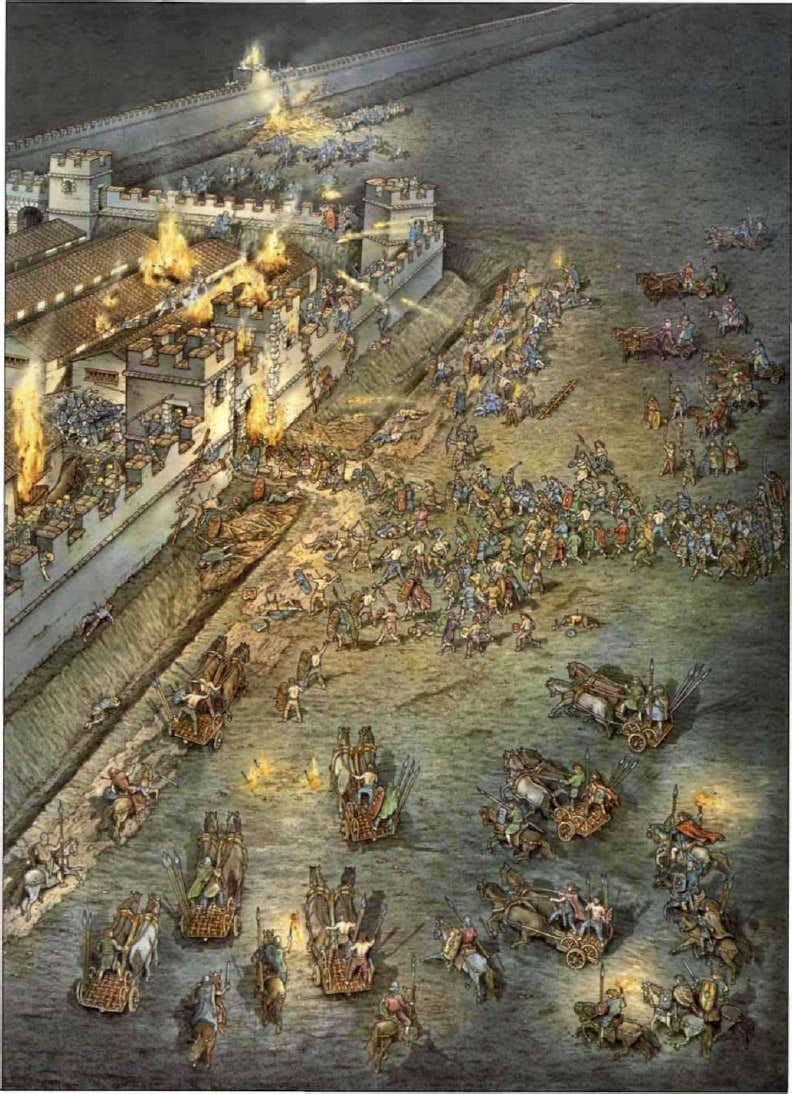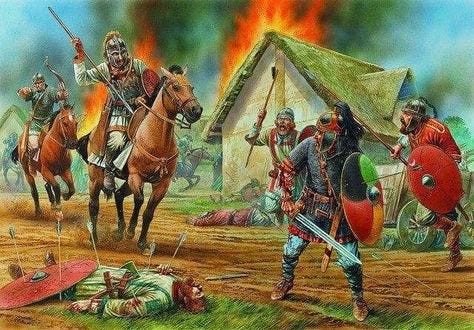The Search for the Historical King Arthur 2nd-4th Centuries.
Looking at the precursors to the Brythonic Heroic Age from the 2nd to the 4th centuries.
Looking at my original compilation of my earlier Twitter threads on important figures from the Brythonic Heroic Age, it became clear that it was just too long for even Substack. I figured I would over the next few days/weeks or so release edited versions of them, with new information, as well as being broken up into a semi-generational format, starting with figures from before the 5th century first in this post, then moving on to the first pre-Roman generation (Coel Hen, Cunedda, etc) and then moving from there. Without further ado, I start chronologically with Lucius Artorius Castus and the Sarmatians.
Lucius Artorius Castus and the Sarmatian connection.
Could a 2nd century Roman commander and a contingent of Sarmatian Cataphracts in Britain be the inspiration for the 5th century warlord?
We begin with Lucius Artorius Castus, a Roman commander attested in two inscription fragments from Croatia. The first from a sarcophagus and the second a memorial.
The Sarcophagus lists his numerous ranks and units throughout his career, one translation as follows.
To the Spirits of the Departed, Lucius Artorius Castus, for himself, the centurion of the leg. III Gallica, also the centurion of the leg. VI Ferrata, also the centurion of the leg. II Adiutrix, also the centurion of the leg. V Macedonica, also the primus pilus of the same, praepositus of the classis Misenensis, twice the praefect of the leg. VI Victrix, the Dux of the three British legions against armed men, the procurator centenarius of the province of Liburniae with 'ius gladi' six times, he himself while alive built this for himself and his family."
Two important ranks here link him to Britain, Praefectus of Legio VI Victrix, and Dux Legionum Trium "Britanicimiarum". As Preafectus of the Legio VI Victrix, he would have been responsible for maintenance of the legionary fortress and management of provisions and equipment. During Castus’ time with the Legio Vi Victrix he was likely stationed in Eboracum (York) the majority of the time, and would have overseen detachments to Hadrian’s wall as well.
Dux Legionum was a temporary title given to those who are operating above their normal position. As Dux Legionum Trium "Britanicimiarum" he likely led an otherwise unknown expedition of three British legions, the II Augusta, the XX Valeria Victrix, and the VI Victrix.
These ranks place him in Britain likely fairly late in his life as normally Prefect of the Legion was one of the last ranks a man would serve as. So what part do the Sarmatians play in this, and how can Castus be linked to them? The main connection here is that Castus likely fought against the Sarmatians and Marcomanni as part of the Legio V Macedonica earlier in his career.
In 175 Marcus Aurelius stationed 5500 Sarmatians in Britain, this contingent seemed to serve in Northern Britain for multiple generations, so with a little conjecture one could say he was possibly given his post in Britain because of his prior experience with said Sarmatians.
We have another angle with possible links to later Arthurian legend and the "Nart Sagas" from the Caucasus not far from Sarmatia. These feature not only a Cup reminiscent to the Grail, that only a worthy warrior could use, but also a white clad woman associated with water.
The Sarmatians were famed for their horsemanship, fielding the feared Cataphract, armored man and horse complete with lance. Very reminiscent of the later Knight in Shining Armor motif we see in later Arthurian Legend
Upon one of the Nart's deaths he gives his sword to his friend to be thrown into the sea, which the friend then lies about twice before finally committing. Sounds an awful lot like Bedivere in Malory's Le Morte d'Arthur.
The Nart Saga's were first written down in the 19th Century, but are assumed to be older. Is this a case of blind coincidence, shared cultural motifs, or original inspiration?
There is also the discussion of Castus' nomen gentilicium, Artorius, which has been proposed as the origin of the name Arthur, although there are multiple possible Celtic origins for the name as well.
Sadly I do not think there is enough evidence to link Castus with the earliest tales of Arthur, and the post-Galfridian tales are so far removed that it is hard to say that these are directly linked, although I do think there is some other merit to this theory.
The conjecture of Castus leading Sarmatians is a bit of a stretch as we have no evidence other than Sarmatians being present in Britain at the same time as him, and the commands given to him in Britain are in no way related to the Sarmatians there. However there is an interesting possibility that they inspired the native Brythonic warriors to revere cavalry, as much of their poetry and praises revolve around cavalry in early welsh sources. This could be linked to the Sarmatians, or the general use of cavalry in late Roman Britain.
Overall I do not think the theory as a whole holds water, but is it fun to think about Roman led Sarmatian Cataphracts fighting Caledonii at Hadrian's wall? It definitely is!
Was Constantine the Great's mother Helena British?
It is often said that Constantine the Great's mother Helena was British Princess, the daughter of King Coel, a legend seemingly starting with Henry of Huntingdon's work Historia Anglorum, and shortly after perpetuated by Geoffrey of Monmouth's Historia Regum Britanniae.
Henry tells us that Constantius (Constantine the Great’s father)
…received in marriage the daughter of the British king of Colchester, whose name was Hoel or Helen, our Saint Helena, by whom he had Constantine the Great. Constantius, a great and accomplished prince, died at York.
Geoffrey greatly expands upon the information Henry of Huntingdon provided and proceeds to make Constantine an ancestor of King Arthur.
Constantine the Great → Constantine II → Uther → Arthur
The aforementioned “British king of Colchester” is often held to be Coel Hen. There are issues with this.
Coel and his contemporaries are the progenitors of the Brythonic Heroic Age, a period that starts after the Roman administration left/ were expelled from Britain, placing his rule solidly after 410a.d. So how could a man who ruled after 410, be grandfather to a man born in 272? The answer is surprisingly easy to track down.
The answer lies with a British noblewoman named Elen ferch Eudaf. Elen was the daughter of Eudaf Hen (Octavius the Old) a Romano British ruler with a floruit likely in the early 4th century. Eudaf is an ancestor of many figures we have visited here one way or another. So why might one confuse Elen ferch Eudaf, for Helena, mother of Constantine I? Well aside from the similarity of names lets make some other connections.
Both were married to Emperors. Helena to Constantine's father Constantius (Emperor from 293-306), and Elen to Magnus Maximus (the famous Macsen Wledig of Welsh legend, Emperor from 383-388) With Magnus Maximus marrying twice with the second Marriage being to Elen, and siring many children by her.
This is where another important connection can be made and what seems to have maybe been the actual cause for conflating Elen with Helena, and that is that one of Elen's sons was according to tradition also named Constantine. Elen and Magnus’ son Constantine is known by the Britons as Custennin Fawr and seems to have ruled somewhere in the North of Wales prior to Cunedda.
It is easy now to see how these two Historical figures became conflated through years of telling and retelling and of very similar names and situations. So was Constantine the Great half British? No, but it is easy to see why that myth began!
Magnus Maximus The Usurper Emperor Behind Arthur’s European Campaigns
Maximus was born sometime around 335ad in Gallaecia, the son of general Flavius Julius Eucherius. Maximus claimed relation to Flavius Theodosius, who he served under during The Great Conspiracy. From 367–368 Seemingly coordinated attacks by the Picts, Scotti, Attacotti, Saxons, and Franks harried the Island of Britain, this event is known as The Great Conspiracy. Maximus, under Theodosius proved to be a capable leader, helping to quell The Great Conspiracy, as well as serving in Africa in 373.
He was then given a post in Britain in 380, and fought against a Pict and Scotti incursion the next year. In the coming years the emperor Gratian had become increasingly unpopular, eventually leading to Maximus being proclaimed emperor by his own troops. He then led campaigns in Gaul using soldiers from Britain, weakening Britain's defenses considerably. Maximus then used these troops to take on Gratian and his army, eventually defeating him, and leading to Gratian's death.
He then proceeded to rule Britain, Gaul, Spain and Africa from his established capital at Augusta Treverorum. He became known as a defender of the church for some time, and in particular went after heresy harshly.
In the ensuing years Magnus became quite popular, though he continued to keep pressure on Valentinian II eventually driving him to Theodosius I, son of the previously mentioned Flavius Theodosius (A relation of Maximus' if we are to believe he was related to Flavius Theodosius)
Maximus was ultimately defeated at the Battle of Poetovio, surrendering at Aquileia and was executed.
Many of you are probably wondering "what does this have to do with Arthur?" A number of events in Maximus' life tie in to the greater Arthurian legend, with Maximus himself being stated to be an ancestor of Arthur in many sources.
Arthur is often stated to have made war in Gaul, and then upon Rome, even killing an Emperor, leading to the creation of his own Western-European Empire. This is likely inspired by Magnus Maximus' exploits as a usurper emperor, warring in Gaul, and eventually leading to Gratian's death. These are eventually wrapped into Arthur’s story and become his deeds instead of Maximus’.
Magnus Maximus himself is the subject of a tale in the Mabinogion The Dream of Macsen Wledig (Magnus is known in Welsh as Macsen Wledig, Wledig being a title many of you have seen before in this series meaning Lord, or Ruler, or Great Land-Owner) In this tale Magnus falls asleep after a hunt and dreams of a beautiful maiden, and upon awakening he sends his men to the ends of the earth to search for her, leading him ultimately to Caernarfon in Gwynedd. It is found to be Elen, discussed earlier in this article!
Magnus Maximus seems to have been remembered fondly in British legened, even though he is likely a root of some of the later troubles as according to Gildas he deprived Britain of it's Roman garrison, warbands, governors, and the "flower of her youth"



















